Banish the winter blues with plants that enliven gardens during the coldest, bleakest months of the year. Shrubs and small trees chosen for their colorful berries or unusual barks add bright accents and interesting textures to muted garden beds. While it’s best to wait until spring to plant in most cold-winter climates, take a look at these trees and shrubs while your garden is bare to get the best sense of where they can shine in your winter landscape.
Related: How to Enjoy Your Yard in December
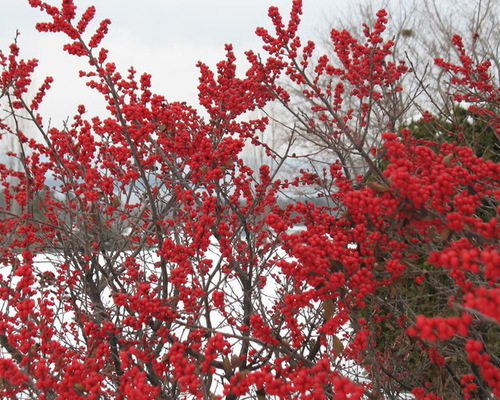
Winter Garden 1: Paintbox Garden, original photo on Houzz
5 Brilliant Berries
1. Winterberry
(Ilex verticillata)
Winterberries, or Christmas berries, may take the cake among other cold-tolerant shrubs for their sheer volume of decorative berries. Ripening in early fall, the berries — in shades ranging from orange and bright red to deep crimson — cling to the twiggy branches like Christmas ornaments throughout winter. Plant both male and female plants together for cross pollination and the best berry production. Branches can be clipped and brought indoors for long-lasting winter arrangements.
Where it will grow: Hardy to minus 40 degrees Fahrenheit, or minus 40 degrees Celsius (USDA zones 3 to 9)
Water requirement: Moderate to regular water
Light requirement: Full sun
Mature size: 6 to 10 feet tall and wide
2. English Holly
(Ilex aquifolium)
Glossy pointed leaves and crimson winter berries make this a holiday favorite. Site the shrubs at the back of garden beds where you won’t mind their prickly leaves, or keep them sheared into decorative hedges or foundation plants.
Caution: English holly can be invasive in the northwest United States. In this region, skip planting altogether or choose only male or seedless female varieties.
Where it will grow: Hardy to 0 degrees Fahrenheit, or minus 17.8 degrees Celsius (zones 7 to 9)
Water requirement: Moderate to regular water
Light requirement: Full sun to partial shade
Mature size: Slow growth to 40 feet tall and 25 feet wide
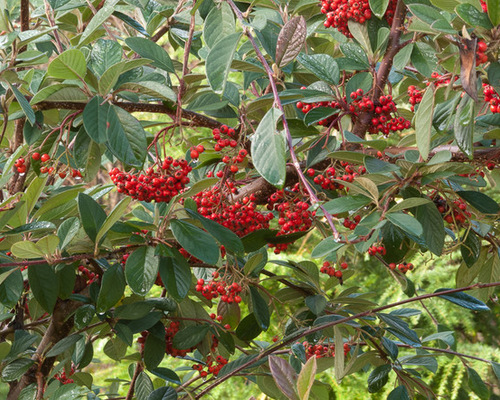
Winter Garden 2: Le jardinet, original photo on Houzz
3. Cotoneaster
(Cotoneaster spp.)
Cotoneasters range from small, low-growing ground covers to rangy trees up to 25 feet tall. Their form also varies — some plants hold their berries in pendulous clusters, while other varieties have small berries studded along the branches. Cranberry cotoneaster (Cotoneaster apiculatus, zones 4 to 7) is a particularly cold-hardy variety, with small leaves and showy red berries. Cotoneaster berries are favored by birds and provide a welcome food source in winter.
Caution: Cotoneaster is invasive in some regions. Please check before planting.
Where it will grow: Hardiness varies by species, some are hardy to as low as minus 25 degrees Fahrenheit, or minus 31.7 degrees Celsius (Zone 4).
Water requirement: Moderate; regular water in hot climates
Light requirement: Full sun
Mature size: Varies widely by species
4. Chokeberry
(Aronia spp.)
These shrubs offer four-season interest with white or pink flowers in spring, attractive medium green foliage in summer turning to bronze and red in fall, and showy berries in winter. Choose between species with either brilliant red (A. arbutifolia) or black (A. melanocarpa) berries. Plant as part of mixed borders or add to woodland gardens.
Where it will grow: Hardy to minus 25 degrees Fahrenheit, or minus 31.7 degrees Celsius (zones 4 to 9)
Water requirement: Moderate to regular water
Light requirement: Full sun
Mature size: 5 feet tall and up to 6 feet wide
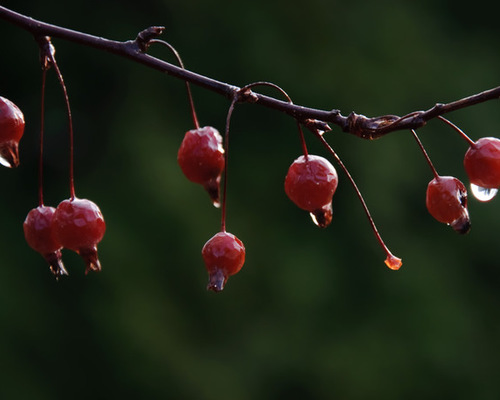
Winter Garden 3: Barbara Pintozzi, original photo on Houzz
5. Crabapple
(Malus spp.)
Small trees native to North America, Europe and Asia, crabapples are excellent landscape specimens for their showy blooms, decorative berries and well-behaved forms. If you’re selecting for winter interest, keep in mind that not all crabapples fruit. To avoid a mistake, choose a specific variety — such as crimson ‘Red Jade’ or yellow ‘Harvest Gold’ — or browse the nursery selection in winter when trees are fruiting.
Where it will grow: Hardy to minus 25 degrees Fahrenheit, or minus 31.7 degrees Celsius (zones 4 to 9)
Water requirement: Moderate to regular water
Light requirement: Full sun
Mature size: Size varies by species; most are small trees about 15 to 20 feet tall, but some can grow to 30 feet.
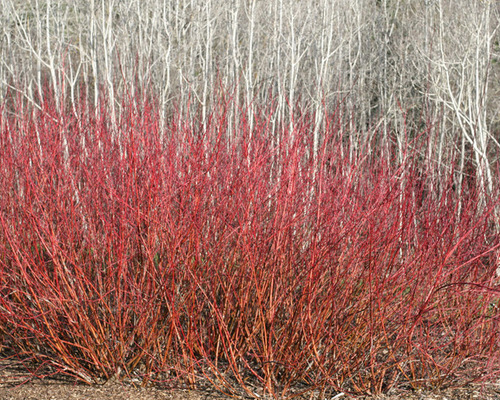
Winter Garden 4: Tom Debley, original photo on Houzz
5 Best Barks
1. Redtwig Dogwood
(Cornus sericea)
The spectacular red bark of the thin multistemmed branches of this North American native lights up barren winter landscapes with a wash of color. Like most shrubby dogwoods, redtwig dogwood spreads rapidly through underground stems. To keep it from taking over, prune it hard in late winter. Cut branches can be brought indoors and will form roots when placed in vases with fresh water.
Where it will grow: Hardy to minus 45 degrees Fahrenheit, or minus 42.8 degrees Celsius (zones 2 to 7)
Water requirement: Moderate to regular water
Light requirement: Full sun to partial shade
Mature size: 7 to 9 feet tall and spreads up to 12 feet wide
2. Paper birch
(Betula papyrifera)
Birches of all types are beloved for their pale, peeling bark and graceful upright forms. North American paper birch (B. papyrifera) has snowy white bark is larger than the commonly available European white birch (B. pendula). To highlight the pale bark, plant either species against a dark backdrop, such as a deep green hedge or dark fence, for the most contrast.
Where it will grow: Hardy to minus 45 degrees Fahrenheit, or minus 42.8 degrees Celsius (zones 2 to 7)
Water requirement: Moderate to regular water
Light requirement: Full sun
Mature size: 50 to 90 feet tall, 25- to 40-foot-wide canopy; can be kept small with annual pruning
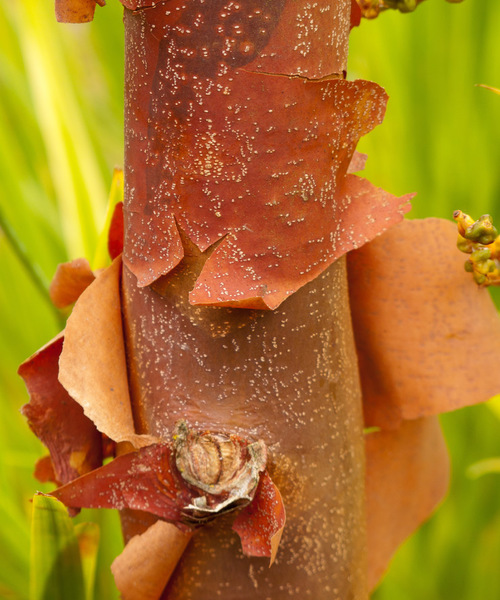
Winter Garden 5: Le jardinet, original photo on Houzz
3. Paperbark Maple
(Acer griseum)
Native to China, paperbark maples aren’t commonly available but are worth tracking down for their beautiful foliage and unusual bark. In fall the silvery green leaves turn crimson, while in winter all attention is drawn to the smooth cinnamon-brown trunks with bark that peels back in delicate curls.
Where it will grow: Hardy to minus 25 degrees Fahrenheit, or minus 31.7 degrees Celsius (zones 4 to 8)
Water requirement: Moderate to regular water
Light requirement: Sun to partial shade
Mature size: 25 feet tall and 10 to 20 feet wide
4. Quaking Aspen
(Populus tremuloides)
Quaking aspen is another tree prized for its smooth pale bark, and is closely related to European aspen (P. tremula). Both make excellent landscape trees in areas with temperature extremes — cold winters and hot summers — but do not thrive in mild-winter or coastal regions. Aspens looks best planted in groups, such as on the fringe of a property, where they can form a grove.
Where it will grow: Hardy to minus 55 degrees Fahrenheit, or minus 48.3 degrees Celsius (zones 1 to 6)
Water requirement: Moderate to regular water
Light requirement: Full sun
Mature size: Varies by variety, from 20 to 60 feet tall and from 15 to 30 feet wide
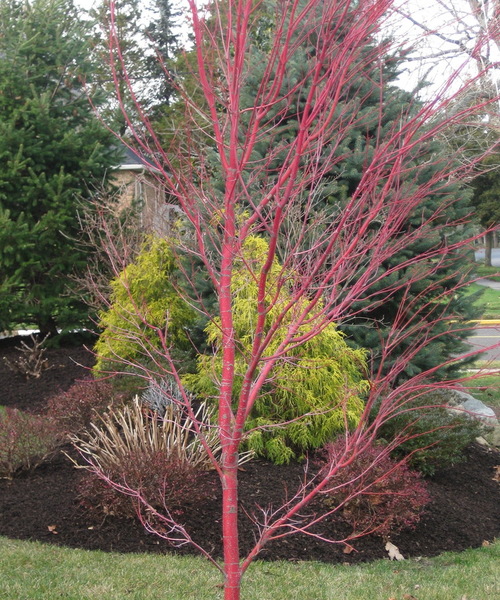
Winter Garden 6: Barlow Flower Farm, original photo on Houzz
5. Coral Bark Japanese Maple
(Acer palmatum ‘Sango-kaku’)
Small-scale coral bar
Japanese maples are perfect for adding winter interest to small gardens. Plant one in the front yard as a specimen tree or grow it in a large container on the patio. Cold weather and sun exposure intensify the coral color of the bark, deepening it to crimson. The leaves turn gold in fall.
Where it will grow: Hardy to minus 20 degrees Fahrenheit, or minus 28.9 degrees Celsius (zones 5 to 8)
Water requirement: Moderate to regular water
Light requirement: Full sun to partial shade in hot-summer regions
Mature size: 15 to 20 feet tall and wide

